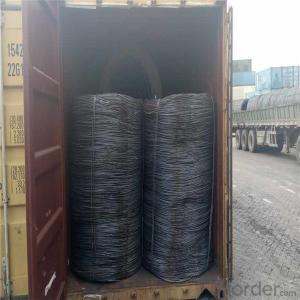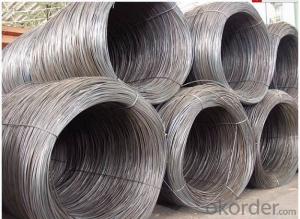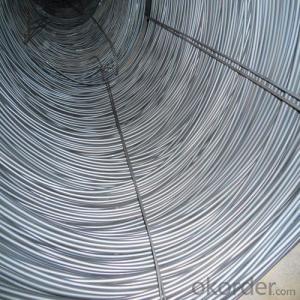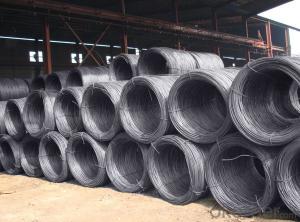Low Carbon Steel Wired Rod SAE1006 / SAE1008B
- Loading Port:
- Tianjin
- Payment Terms:
- TT OR LC
- Min Order Qty:
- 100 m.t.
- Supply Capability:
- 16472 m.t./month
OKorder Service Pledge
OKorder Financial Service
You Might Also Like
Specification
Steel wire is mainly used for prestressed and posttensioning technology in various
shapes of prestressed concrete structures,and widely used for civil engineering
construction, such as large scale railroad, highway bridges, building trusses,
overhead crane beams, industrial and prefabricated concrete floor, wall board,
tubular piles, PC water pipes, TV towers and nuclear power station, ETC. Active
strandards:GB/T5223, ASTMA421, BS5896, JISG3536, ISO6934, EN10138 or other special
required standards.
Our service:
(1) We cooperate with famous factories with advanced equipment and well trained workers.
(2) We can provide factory price with trading company service.
(3) We continuously work on the improvement of our processes, guaranteeing
consistently high standards of quality to keep none compensation.
(4) We guarantee 24 hours response and 48 hours solution providing service.
(5) We accept small order quantity before formal cooperation.
(6) We deliver the agreed quality at the agreed time, reacting to changes in
customer wishes in a flexible way.
(7) Due to our volume and selling power, we have excellent freight rates with
shipping lines.
(8) We strive to always be fair and honest in our dealings with customers.
(9) We strive to work together with customers to achieve much more than we can
achieve alone.
(10) Through our passion and commitment we aim to be a market leader in all our
key markets. To maintain our position as market leader we must continue to add
value in all that we do.
Product Description :
Standard | AISI, ASTM, BS, DIN, GB, JIS |
Material/steel grade | Q195-Q235,SAE1006B,SAE1006CR, SAE1008B, SAE1008CR, SAE1010B, SAE1018B, or according to customers requirements |
Wire Gauge | 5.5-12mm |
Coil weight | 1.8-2.1mts |
MOQ | 25MT |
Delivery Time | 15-30 days after receipt of L/C or deposit by T/T |
Packing | In coil and load in container, if large quantity, by bulk vessel; Can be packed as customers' special requirements |
Payment terms | 1).100% irrevocable L/C at sight. 2).30% T/T prepaid and the balance against the copy of B/L. 3).30% T/T prepaid and the balance against L/C |
Application | widely used in machinery parts, manufacturing industry, electronics industry, metal tools and others |

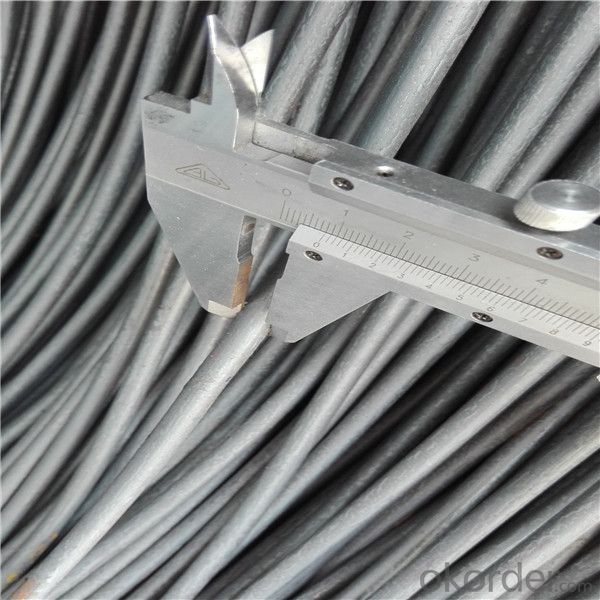
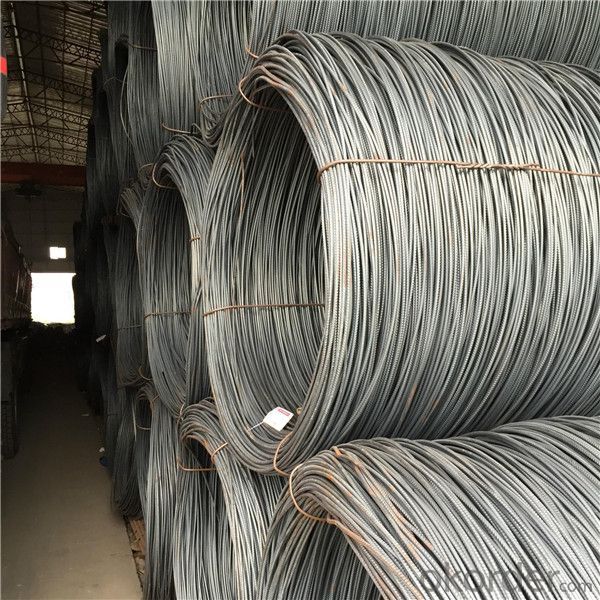
Application :
Mainly used in building and construction as binding wire, tie wire and baling wire; also can be make
for wire mesh.
Packing :
Hot-rolled wire rod is held in a unit with at least four steel straps in the
transverse direction and transported and stored without further packaging.
Before
the steel strapping is applied, the wire rod must be sufficiently compressed.
The strapping is fixed in the transverse direction with a single circumferential
strap so that the strapping does not slip and cause the coil to come apart.


FAQ:
1.Q:Can you accept mixed order?
A: Yes, mixed acceptable .
2. Q: How can I buy CNBM products in my country?
A:Please send us an inquiry or email ,we will reply to you if there is distributor in your country
3. Q: Can we visit your factory?
A: Warmly welcome. Once we have your schedule, we will arrange the
professional sales team to follow up your case.
4. Q: How long does it take to get the product if i place an order?
A:With the process of your requirements,we will pack and deliver in 3
-7 days. If it is by sea shipment,it will take 15-45 days depending on different locations
- Q: What is the maximum allowable deviation in diameter for steel wire rod?
- The maximum allowable deviation in diameter for steel wire rod depends on the specific standards and specifications set by different industries and applications. However, in general, the maximum allowable deviation in diameter for steel wire rod is typically specified as a percentage or a specific tolerance range. For example, in the steel industry, the maximum allowable deviation in diameter for steel wire rod can range from +/- 0.010 inches to +/- 0.020 inches, depending on the specific grade and intended use of the wire rod. This means that the diameter of the wire rod can be slightly larger or smaller than its specified value within this tolerance range. It is important to note that these tolerances may vary depending on the specific industry requirements and the intended application of the steel wire rod. Therefore, it is essential to consult the relevant standards, specifications, and guidelines provided by the industry or application to determine the maximum allowable deviation in diameter for steel wire rod in a particular context.
- Q: What are the main factors influencing the choice of steel wire rod order customer feedback process?
- The main factors influencing the choice of steel wire rod order customer feedback process include the quality and reliability of the product, customer satisfaction and loyalty, effective communication channels, prompt resolution of issues, and the overall reputation and trustworthiness of the supplier.
- Q: How are steel wire rods used in the production of fishing lines for catching fish?
- Steel wire rods are used in the production of fishing lines for catching fish as they provide strength and durability to withstand the tension generated during the fish-catching process. These wire rods are typically coated or encased in a protective material, ensuring resistance against corrosion and abrasion. This sturdy construction enables fishermen to securely hook and reel in fish of various sizes without the risk of the line breaking.
- Q: What are the different testing methods used for steel wire rod?
- There are several testing methods used for steel wire rod, including tensile testing, bend testing, hardness testing, ultrasonic testing, magnetic particle testing, and visual inspection. These methods help ensure the quality and durability of steel wire rod by evaluating its mechanical properties, such as strength, ductility, and resistance to deformation and defects.
- Q: How is the surface roughness of steel wire rod measured?
- Various instruments and techniques can be utilized to measure the surface roughness of steel wire rod. One widely employed approach involves the use of a specialized device called a profilometer, which is capable of determining the surface texture of a material. To assess the roughness of steel wire rod using a profilometer, a small portion of the rod is carefully selected and thoroughly cleaned to ensure precise readings. The profilometer is then positioned onto the rod's surface and systematically moved across it in a controlled manner. Throughout this movement, the instrument captures the variations in height on the surface, effectively creating a profile that represents the roughness. The profilometer typically provides measurements in terms of Ra (roughness average) or Rz (average maximum peak-to-valley height). Ra quantifies the average roughness by calculating the arithmetic mean of the absolute values of the height deviations from the mean line. On the other hand, Rz evaluates the average height difference between peaks and valleys within a specified length of sampling. Another technique employed for measuring surface roughness is the utilization of a surface roughness comparator, which is also referred to as a roughness gauge or roughness standard. This instrument consists of a collection of reference surfaces that possess predetermined roughness values. By comparing the surface of the steel wire rod to these reference surfaces, the roughness can be determined based on the closest match. It is important to consider that the selection of a specific method for measuring the surface roughness of steel wire rod may depend on factors such as the desired level of accuracy, the size and shape of the rod, and the availability of appropriate equipment.
- Q: How is steel wire rod tested for resistance to intergranular corrosion?
- Steel wire rod is tested for resistance to intergranular corrosion through a process called the Strauss test, also known as the ASTM A262 test. This involves subjecting the steel wire rod to a specific corrosive solution, such as a boiling nitric acid mixture. The wire rod is then visually inspected for signs of intergranular corrosion, such as cracking or disintegration. Additionally, metallographic examination may be conducted to analyze the microstructure of the wire rod and determine the extent of intergranular corrosion.
- Q: How does the electrical conductivity of steel wire rod vary with different wire drawing processes?
- Different wire drawing processes can result in varying electrical conductivity for steel wire rods. Wire drawing involves pulling a wire rod through a series of dies to decrease its diameter and increase its length. This process can impact the electrical conductivity of the steel wire rod due to multiple factors. To begin with, reducing the diameter during wire drawing can lead to an increase in electrical conductivity. When the wire rod passes through the dies, its cross-sectional area decreases, resulting in a higher concentration of conductive material in a smaller space. This concentration of conductive material can enhance the electrical conductivity. Moreover, the wire drawing process can influence the microstructure of the steel wire rod, which subsequently affects its electrical conductivity. Deformation and strain during wire drawing can cause changes in the crystal structure and grain size of the steel. These changes significantly impact the electrical conductivity. For instance, grain refinement resulting from the wire drawing process enhances electrical conductivity by reducing electron scattering. Furthermore, the wire drawing process can introduce impurities or defects into the steel wire rod, which can disrupt its electrical conductivity. These impurities or defects act as scattering centers for electrons, thereby reducing the overall electrical conductivity. Additionally, the choice of lubricants and cooling methods during wire drawing can influence the electrical conductivity of the steel wire rod. Lubricants minimize friction and heat during the drawing process, preventing the formation of oxides or other surface contaminants that could hinder electrical conductivity. Effective cooling methods also maintain the desired microstructure and prevent the formation of detrimental phases that could impact electrical conductivity. In conclusion, the electrical conductivity of steel wire rods varies with different wire drawing processes. Factors such as diameter reduction, changes in microstructure, introduction of impurities or defects, and choice of lubricants and cooling methods all impact the electrical conductivity. Considering these factors carefully during the wire drawing process helps achieve the desired electrical conductivity for specific applications.
- Q: Can steel wire rod be recycled?
- Yes, steel wire rod can be recycled. Steel is a highly recyclable material, and the recycling process for steel wire rod is relatively straightforward. The recycling process typically involves collecting the discarded steel wire rod, separating it from any contaminants, and then melting it down to be reformed into new steel products. Recycling steel wire rod helps conserve natural resources, reduces the need for mining and manufacturing new steel, and also has environmental benefits by reducing greenhouse gas emissions and energy consumption associated with the production of new steel.
- Q: Round steel. Wire rod. Is a high wire a kind of thing?
- Are made of billets... The surface of the round steel is smooth. The surface of the wire rod is the same as that of the screw. A high wire is the same as a round bar, but it rolls up. That's probably it
- Q: How is steel wire rod used in the manufacturing of wire mesh?
- Steel wire rod is used in the manufacturing of wire mesh by first being drawn through a series of dies to reduce its diameter and increase its length. This process, known as wire drawing, results in a thin, continuous wire that is then woven or welded together to create wire mesh. The high tensile strength and durability of steel wire rod make it an ideal material for producing wire mesh, which is widely used in various applications such as fencing, construction, and filtration.
Send your message to us
Low Carbon Steel Wired Rod SAE1006 / SAE1008B
- Loading Port:
- Tianjin
- Payment Terms:
- TT OR LC
- Min Order Qty:
- 100 m.t.
- Supply Capability:
- 16472 m.t./month
OKorder Service Pledge
OKorder Financial Service
Similar products
Hot products
Hot Searches
Related keywords
